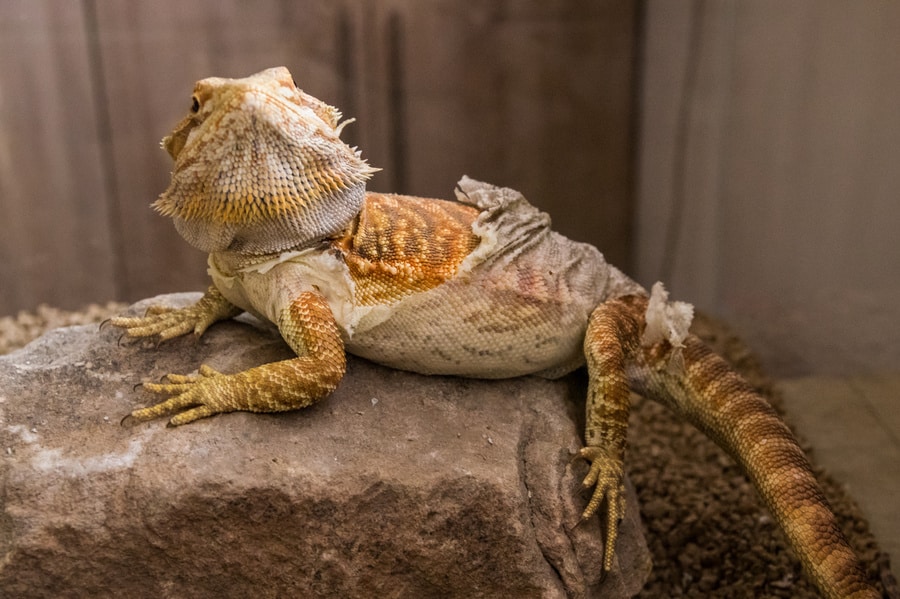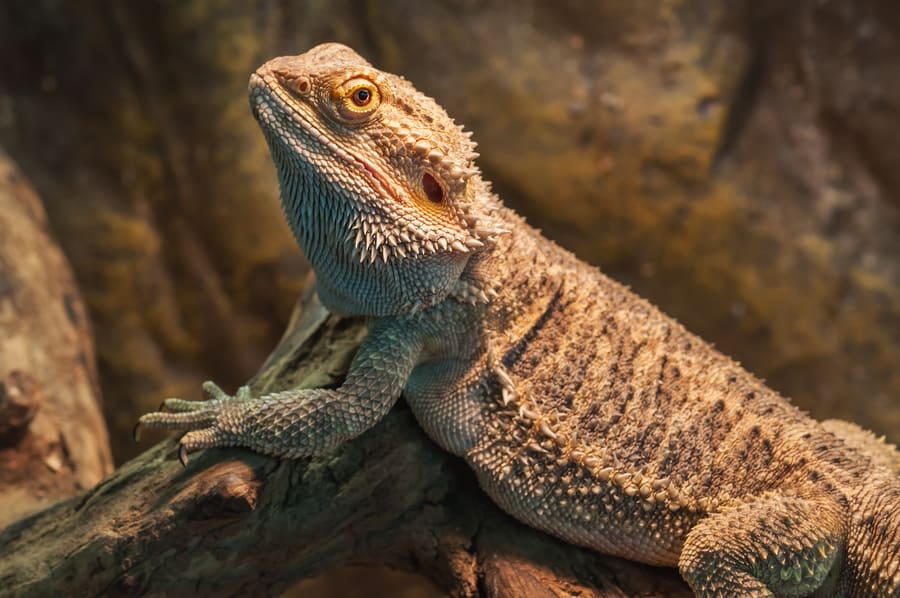
Shedding is the process of growing out of old skin and replacing it with a new one. But why do bearded dragons shed their skin and what should you know about this process? Find out everything you need to know about shedding in the following article.
There are generally two reasons why your bearded dragon will shed its skin: because it’s growing or because the skin is damaged. Normally shedding skin is no cause for concern and a natural healthy process.
Unlike humans who grow by stretching our skin, bearded dragon skin is made from a protein called, keratin. Keratin is not stretchy whatsoever and has little room for growth, so when your bearded dragon grows, it has to shed its skin.
Because growth is a common reason for shedding, it shouldn’t be a surprise that shedding occurs the most often in baby and juvenile bearded dragons (more on the frequency in the sections below). As your bearded dragon gets older, however, it will begin to shed less frequently. The other reason for shedding, skin damage, will most commonly occur in adult beardies. A bearded dragon’s skin can become damaged if it gets dirty, scraped, cut, or otherwise impacted by its environment. After the skin becomes too damaged, your bearded dragon will shed it in favor of a new protective layer.
How Bearded Dragons Act When Shedding?
Shedding is not painful for bearded dragons, but it is uncomfortable. It does make sense though, they are getting rid of their old skin and replacing it with a new one. When shedding, your bearded dragon will likely be irritable and will feel itchy as it sheds out of its skin.
When your bearded dragon is about to shed, its skin will become tight and will start to turn a dull color. In fact, you will always see a change in your bearded dragon’s skin color when it’s about to shed. When your bearded dragon is on the brink of shedding, its skin will turn white.
This change in appearance often worries knew Dragon owners, but don’t worry, it’s completely normal. When shedding, you’ll notice many bearded dragons rubbing their heads and bodies against the décor in the vivarium and within the substrate. This is the natural way in which your bearded dragon works through its shed, so all that rubbing is normal.
Your bearded dragon might also have a change in personality when it’s shedding. As mentioned above, shedding is not comfortable and does take up a considerable amount of energy. So, don’t be surprised if your bearded dragon seems tired, grumpy, and doesn’t respond as well to being handled. In some cases, your bearded dragon will also have less of an appetite before it sheds.
How to Help Bearded Dragon Shed
For new bearded dragon owners, it may seem tempting to try everything you can to help your bearded dragon shed. But there are some definite dos and don’ts for owners who want to make shedding easy for their bearded dragon.
Below are the best tips for helping your bearded dragon through the shedding process.
Leave Your Bearded Dragon Alone
The shedding process has been around for millions of years, so the best thing you can do to help your bearded dragon through the shedding process is to let it be. There is no dire need to bathe your bearded dragon, rub oil on its skin, or rub the skin off yourself. In fact, pulling the skin off your bearded dragon will harm your beardie and may cause skin infections.
Give Your Beardie A Luke-Warm Bath
Even though a bath is not necessary, it can help get the already flakey dead skin off your bearded dragon. Bearded dragon skin is waterproof, so the only way a bath will be beneficial to the shedding process is if the skin is already broken, otherwise, the bath is just a great way to bond with your bearded dragon.
When bathing your bearded dragon during the shedding process, try not to rub the skin too hard and don’t pull any skin off. Instead, gently pet your bearded dragon from head to tail and let any dead skin come itself.
Increase Vivarium Humidity
A commonly used practice among the reptile community is to increase the humidity of your bearded dragon’s vivarium during shedding. Adding a little more moisture to your bearded dragon’s environment will help make the shedding process more effective.
In the wild, bearded dragons will often burrow into the ground—up to a foot underneath the dirt—when shedding because it’s more humid. So, try mimicking that slightly higher humidity to help the process along.
Generally, your bearded dragon tank should be around 30 to 40 percent humidity. When your bearded dragon is shedding, however, you can increase the humidity, but keep it below 55 percent. While a little humidity increase will help your Dragon shed, too much humidity can cause bacterial and fungal infections.
You don’t need to purchase a fancy humidifier to increase the humidity in the tank. For some easy ways to increase the humidity in your bearded dragon tank, try:
- Spraying the tank in the morning and evening to mimic morning and evening dew.
- Add water dishes to the tank.
- Add live plants.
- Use a fogging device that can release fog at intervals throughout the day.
As with any changes you make to your bearded dragon’s environment, you’ll want to make sure you monitor the levels of humidity. To do so, try using a hygrometer or temperature/humidity detecting device and placing it in the tank. Just remember to place the hydrometer in the center of the tank, otherwise, it can give inaccurate readings.
Set Up Vivarium Décor
Not only does the vivarium décor provide shelter and hiding places for your beardie, but it can also help make the shedding process easier. When your beardie is shedding, it wants to rub up against anything it can to help the skin become loose and shed off naturally.
By having various décor pieces in your vivarium, your beardie can have multiple options to choose from. If it’s the first time you’ve seen your beardie shed, trying to watch it to see what piece of vivarium décor it prefers to rub up against. If there is one kind that it prefers, try adding more of that kind of décor to the vivarium for its next shed.
Some popular choices for vivarium décor include:
- Rocks (avoid heating rocks because these can harm your beardie)
- Branches
- Logs
- Hideaway, burrow, or cave
- Flagstone or slate
- Sterilized bones
Choose the Right Substrate
When choosing a substrate for your bearded dragon habitat, it’s best to choose a substrate that won’t be accidentally eaten by your bearded dragon. In the substrate market, loose particle substrate, such as sand and shredded newspaper, and non-particle substrates, such as Reptile Carpet and tile. If you do choose tile, go with ceramic, slate, or linoleum and avoid glass and metals as these can be unsafe for your bearded dragon. Generally, the shedding will be more effective in loose substrate tanks because the bearded dragon will have more material to rub against. If you do choose a non-particle substrate, just make sure you have enough decorations.
Do Oils and Shedding Aids Help Bearded Dragon Shedding?
While there are many products that claim to help reptiles with their shedding, they really aren’t necessary. However, some beardie owners do use Aloe-based oils and Shed Aid products to help skin that has already cracked. These products will only help if the skin is cracked and in the middle of shedding by moisturizing any exposed new skin.
Can You Pull The Skin Off a Bearded Dragon When Shedding?
Never pull the skin off your bearded dragon when it is shedding. While some people think that pulling off the skin will help the shedding process go faster, it will only damage your bearded dragon’s skin. Not only does it damage the skin but pulling off the skin will be painful for your beardie and will likely lead to an infection.
If you want your bearded dragon’s shedding process to go smoothly and painlessly, DON’T pull off the skin. Let your bearded dragon shed by itself.
How Long Does it Take for the Shedding Process?
For a healthy and active bearded dragon, the shedding process should take about a week from start to finish. However, it’s also normal for it to take a little longer than that. You really only need to worry if your bearded dragon is taking too long to shed if it’s been more than three weeks.
The time it takes for a bearded dragon to shed also depends on its age:
- Baby (0 to 6 months) bearded dragons take about 1 to 3 days to shed.
- Juveniles (6 months to 1 year) take about a week to shed.
- Adults (1 year and older) take up to 3 weeks to shed.

Lethargy & Shedding?
It is perfectly common for your bearded dragon to be sleeping during the day while it is shedding. Because shedding is uncomfortable, many beardies do choose to be less active while the process works itself out.
Mostly, your bearded dragon may not greet you as early in the morning and may go to bed earlier than normal. However, a less active bearded dragon will take longer to shed because it is moving less and not actively working to shed its skin.
When your bearded dragon is shedding, it shouldn’t be too lethargic; you should still be able to wake your beardie up and it should still be moving around. If your bearded dragon is abnormally tired and motionless, it’s best to check your vivarium settings and call your vet for further guidance.
How Frequently Will Shedding Occur?
How frequently your bearded dragon will shed is another factor that is directly related to the age of your Dragon. Generally, the younger the bearded dragon the more it will shed. You can also expect more shedding to occur up until it is about 18 months old and full-grown. Below you will find a table that outlines what to expect for shedding at each age.
| Category | Age Range | What to Expect |
| Baby | 0 to 6 months | Shedding nearly every week. |
| Juvenile | 6 months to 12 months | Most rapid growth is done; shedding will occur every other week or so (up to 3 times a month). |
| Older Juvenile | 12 months to 18 months | Beardie is nearly fully grown. Shedding will start to slow. |
| Adult | Over 18 months | Beardie is full grown; shedding occurs only a few times a year. |
Do Bearded Dragons Eat Their Shed?
Like many other reptiles, bearded dragons will eat their own skin after it sheds it off. In fact, you may see your bearded dragon bite its own skin off when it’s shedding. But why do they do this?
Bearded dragons eat their shed for a few reasons. Firstly, bearded dragon skin is full of the nutrients, such as calcium, that it needs to survive. So, eating its own skin is a natural instinct and while may appear strange, is completely normal.
Secondly, eating its shed is a natural way to prevent predators from finding the bearded dragon’s territory. While there is not a ton of research supporting this, it may be an added benefit of eating shedded skin.
In captivity, however, eating shed could cause health issues if the bearded dragon’s vivarium is not clean. Without a clean tank, the shed could land in fecal material and urine, which is not something your beardie should ingest. But if you keep your bearded dragon’s tank clean and free from poo and urine, your bearded dragon should be fine to eat its shed.
Will Bearded Dragons Eat While Shedding?
It’s fairly common for bearded dragons to avoid their food when they are about to shed or in the shedding process. It’s so common that it’s even been nicknamed the ‘shedding blues.’ Most bearded dragons will be less active and hide away in their burrows more than usual leading up to shedding.
However, their food boycott will typically only last a few days leading up to their shed. If you don’t notice the other signs of shedding, it’s best to monitor your bearded dragon for other abnormal behaviors. As always, you know your bearded dragon best and should call the vet to get a check-up if you think something else is bothering your beardie.
Do Bearded Dragons Like to Be Held When Shedding?
Whether your bearded dragon likes to be held when shedding will depend on its overall temperament and socialization. If you have a good bond with your bearded dragon, there shouldn’t be any issue holding it when it’s shedding. Additionally, if your bearded dragon has a healthy diet and ideal vivarium settings, it will likely have an easier time with the shedding process and maybe more comfortable being picked up.
However, some bearded dragons may be more irritable when shedding, so watch for signs of stress and don’t pick up your bearded dragon if it’s hiding in its burrow; it’s best to let it sleep if that’s the case. You won’t harm your beardie by picking it up, but it might not want as much human interaction when it’s shedding.
What if My Beardie is Not Shedding?
Especially if you are transitioning from having a baby beardie shed weekly to an adult that sheds a couple of times a year, you might be worried that your bearded dragon isn’t shedding enough.
If an adult bearded dragon is not shedding, you probably don’t need to worry as long as your beardie’s vivarium is set to the correct UV settings, temperature gradient, humidity levels, and diet. With the right environment and diet, your beardie will shed when it needs to, which may be only a few times a year for adults.
However, if you feel that everything in your vivarium is set up correctly and your beardie isn’t acting normally, then it’s best to double-check those settings. If everything still seems in order, contact your vet for a check-up. But when should you be concerned about your beardie not shedding? While most shedding-related issues pertaining to the quality of care, the most common problems are your bearded dragon is experiencing ‘stuck shed’ or is lacking nutrients.
Stuck Shed
Stuck shed typically affects the top of the head, feet, tail, eyes, and belly of your beardie. Basically, “stuck shed” is when pieces of skin don’t come off during shedding. When this occurs and isn’t treated, the skin can dry up and tighten around the area (remember, beardies usually shed when they are growing or when their skin is damaged.).
If left untreated, your bearded dragon’s skin could become so tight that it could lose a limb or tail. This is because the swelling around the area could cut off their blood supply. Losing limbs only occurs in extreme cases, however. Most of the time, any retained or stuck shed will be removed the next time your beardie sheds.
In any case, if it’s taking your beardie too long to shed (see how long it should take your beardie to shed above) or you notice swelling, dry patches that don’t shed off, and more than the normal shedding discomfort, contact your vet immediately for the next steps.
Substrate and Not Enough Décor
One cause of stuck shed is that your beardie doesn’t have the right substrate or vivarium décor to rub against. When your bearded dragon is shedding, it will rub its body against the pieces in the vivarium to help the shed come off naturally. If there is insufficient décor in your vivarium, your beardie might not have enough places to scratch itself.
Additionally, the lack of substrate (the material used on the base of the vivarium) can also be the cause of stuck shed. If your vivarium uses newspaper, tiles, or carpet, your beardie is more susceptible to stuck shed. However, you can add more décor to help with shedding if this is your preferred substrate.
Lack of Nutrients
The other likely culprit of stuck shed is lack of nutrients, and most shedding issues can be related to a vitamin B deficiency. However, other natural vitamins and minerals could be causing shedding issues, such as:
- Calcium
- Magnesium
- Vitamin E
- Vitamin D3
To prevent shedding issues via vitamin and mineral deficiencies, try sprinkling a nutrient supplement on your bearded dragon’s food 2 to 3 times a week (as recommended by VCA Hospitals). Some brands to try are:
- Repti Calcium
- Herptivite
- Flukers
